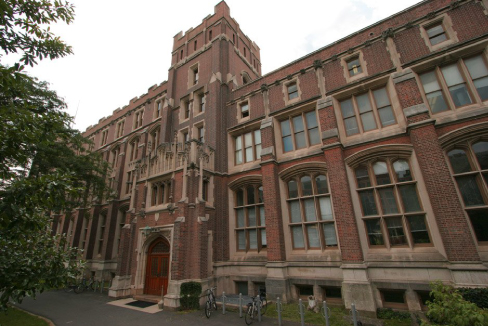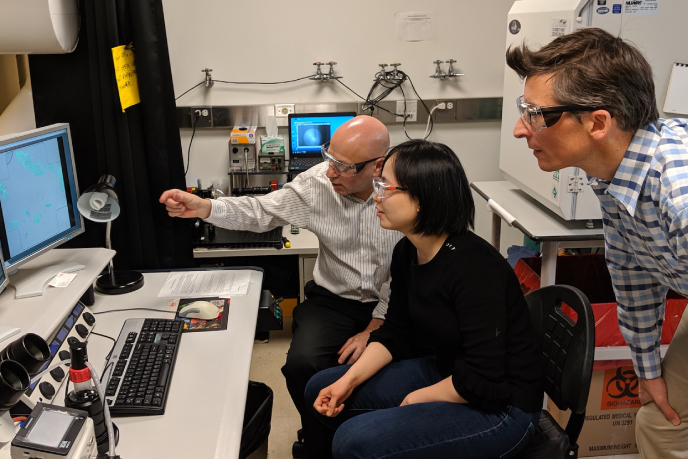Principal Investigator
At a Glance
Increasing concentrations of atmospheric carbon dioxide (CO2) lead to higher concentrations of dissolved CO2in surface seawater. This results in ocean acidification, which may affect the growth of the photosynthetic phytoplankton that form the basis of marine food webs. The Morel group has conducted both field and laboratory experiments to examine the effects of acidification on phytoplankton productivity. The results will enable future assessments and predictions of how CO2 concentration changes impact marine ecosystems.
Research Highlight
About one-third of human-generated CO2 emissions into the Earth’s atmosphere dissolve in surface seawater, increasing the CO2 concentration and decreasing the pH of the seawater. The resulting ocean acidification leads to a host of interrelated chemical and biological consequences. Among the documented biological effects of seawater acidification are changes in the growth of some species of phytoplankton, the photosynthetic organisms that form the primary production base of marine food webs.
In several instances, increased phytoplankton growth rates have been observed at high CO2 concentration, but other experiments have shown no effect or a negative effect. These variable results make it difficult to generalize and to predict how oceanic primary production may respond to ocean acidification. Over the past several years, with support from the Carbon Mitigation Initiative and the National Science Foundation, the Morel group has been carrying out laboratory and field experiments aimed at elucidating the physiological responses of marine phytoplankton to increasing CO2/decreasing pH. The results will enable assessment, and eventually prediction, of future changes in phytoplankton ecology and ocean productivity.
The inconsistent results reported for the effect of ocean acidification on phytoplankton may result from opposite, and partly compensating, effects of increasing CO2 and decreasing pH on the rates of photosynthesis and respiration by the organisms. The Morel group explored these possibilities by independently varying the CO2 concentration and the pH in cultures of a model diatom species (see Figure 1.4), and simultaneously quantifying the organisms’ rates of photosynthesis and respiration using oxygen isotopes.
The results have demonstrated that many organisms maintain constant photosynthesis and respiration rates over a range of pH and CO2 conditions that encompass predicted CO2 changes over the next century and beyond. This remarkable outcome results from the ability of the organisms to maintain efficiently, and with very low energy expenditures, a constant intracellular CO2 concentration for photosynthesis (via their “carbon concentrating mechanism”) and a constant internal pH, despite variations in the external seawater. Species for which maintaining their internal chemistry is either less efficient or more costly will be comparatively more affected by ocean acidification, leading to a shift in species assemblages. These changes have been observed in the few field experiments conducted to date.
High Latitudes
Because high latitudes are inordinately subject to global change (rapid warming and large decreases in pH) the Morel group extended these studies to psychrophilic (i.e., cold-adapted) phytoplankton species. These organisms support some of the most productive regions of the oceans and, because of a short food chain, some of the most efficient and spectacular ecosystems on Earth: from phytoplankton to krill to seals and whales. This work included both field experiments at Palmer Station in the West Antarctic Peninsula and complementary laboratory experiments with model phytoplankton species.
The experiments revealed some fascinating biochemical adaptations that allow certain cold-adapted phytoplankton to grow rapidly at very low ambient temperatures. These include very high cellular concentrations of key proteins (such as Rubisco, the enzyme responsible for the fixation of CO2 during photosynthesis) that cannot be adapted to turn over rapidly when temperatures are near freezing. However, increasing CO2 did not have a significant effect on growth rates, despite a clear downregulation of the organisms’ carbon concentrating mechanism. This result reflects the very low amount of energy required to maintain a high intracellular CO2 concentration, even under very low temperature conditions.

Trace Metals
A poorly studied but potentially important consequence of the CO2-induced acidification of the surface ocean is a change in the bioavailability of trace metals, which play a critical role in the productivity and population dynamics of marine ecosystems. The Morel group conducted laboratory and field experiments designed to quantify the effects of acidification on the bioavailability of iron and zinc, two metals that are essential to the growth of phytoplankton.
In all laboratory and field experiments, acidification decreased the bioavailability of iron, a metal known to limit primary production in large regions of the oceans. This result is consistent with the predicted decrease in the labile concentration of iron under acidic conditions. In the case of zinc, both positive and negative effects on bioavailability were observed at low pH in the laboratory, depending on the mix of organic compounds present in the medium. This variability in response to acidification was also observed in the field and was consistent with changes in the chemical lability of zinc measured by electrochemistry.
References
- Goldman, J.A.L., S.A. Kranz, J.N. Young, P.D. Tortell, R.H.R. Stanley, M.L. Bender, and F.M.M. Morel, 2015. Gross and net production during the spring bloom along the Western Antarctic Peninsula. New Phytologist, 205(1): 182-191. doi:10.1111/nph.13125.
- Hopkinson, B.M., C.L. Dupont, A.E. Allen, and F.M.M. Morel, 2011. Efficiency of the CO2 concentrating mechanism of diatoms. Proc. Natl. Acad. Sci., 108(10): 3830-3837. doi:10.1073/ pnas.1018062108.
- Hopkinson, B.M., Y. Xu, D. Shi, P.J. McGinn, and F.M.M. Morel, 2010. The effect of CO2 on the photosynthetic physiology of phytoplankton in the Gulf of Alaska. Limnol. Oceanogr., 55(4): 2011- 2024. doi:10.4319/lo.2010.55.5.2011.
- Kranz, S. A., J.N. Young, B.M. Hopkinson, J.A.L. Goldman, P.D. Tortell, and F.M.M. Morel, 2015. Low temperature reduces the energetic requirement for the CO2 concentrating mechanism in diatoms. New Phytologist, 205(1): 192-201. doi:10.1111/nph.12976.
- Lomas, M.W., B.M. Hopkinson, J.L. Losh, D.E. Ryan, D.L. Shi, Y. Xu, and F.M.M. Morel, 2012. Effect of ocean acidification on cyanobacteria in the subtropical North Atlantic. Aquat. Microb. Ecol., 66: 211-222. doi:10.3354/ame01576.
- Losh, J.L., F.M.M. Morel, and B.M. Hopkinson, 2012. Modest Increase in the C:N Ratio of N-limited Phytoplankton in the California Current in Response to High CO2. Mar. Ecol. Prog. Ser., 468: 31-42. doi:10.3354/meps09981.
- Losh, J.L., J.N. Young, and F.M.M. Morel, 2013. Rubisco is a small fraction of total protein in marine phytoplankton. New Phytologist, 198(1): 52-58. doi:10.1111/nph.12143.
- Mackey, K., J.J. Morris, F.M.M. Morel, and S.A. Kranz, 2015. Response of Photosynthesis to Ocean Acidification. Oceanography, 25(2): 74-91. http://dx.doi.org/10.5670/oceanog.2015.33.
- Shi, D., S.A. Kranz, J.-M. Kim, and F.M.M. Morel, 2012. Ocean acidification slows nitrogen fixation and growth in the dominant diazotroph Trichodesmium under low-iron conditions. Proc. Natl. Acad. Sci., 109(45): 18255-18256. doi:10.1073/pnas.1216012109.
- Shi, D., Y. Xu, B.M. Hopkinson, and F.M.M. Morel, 2010. Effect of ocean acidification on iron availability to marine phytoplankton. Science, 327 (5966): 676-679. doi:10.1126/science.1183517.
- Tortell, P.D., E.C. Asher, H.W. Ducklow, J.A.L. Goldman, J.H. Dacey, J.J. Grzymski, J.N. Young, S.A. Kranz, K.S. Bernard, and F.M.M. Morel, 2014. Metabolic balance of coastal Antarctic waters revealed by autonomous pCO2 and ΔO2 /Ar measurements. Geophysical Research Letters, 41(19): 6803-6810. doi:10.1002/2014GL061266.
- Xu, Y., D. Shi, L. Aristilde, and F.M.M. Morel, 2012. The effect of pH on the uptake of zinc and cadmium in marine phytoplankton: Possible role of weak complexes. Limnol. Oceanogr., 57(1): 293- 304. doi:10.4319/lo.2012.57.1.0000.
- Young J.N., J.A.L. Goldman, S.A. Kranz, P.D. Tortell, and F.M.M. Morel, 2015. Slow carboxylation of Rubisco constrains the rate of carbon fixation during Antarctic phytoplankton blooms. New Phytologist, 205(1): 172-181. doi:10.1111/nph.13021.
- Young, J.N., S.A. Kranz, J.A.L. Goldman, P.D. Tortell, and F.M.M. Morel, 2015. Antarctic phytoplankton down-regulate their carbon-concentrating mechanisms under high CO2 with no change in growth rates. Mar. Ecol. Prog. Ser., 532: 13-28. doi:10.3354/meps11336.
- Young, J.N., and F.M.M. Morel, 2015. Biological oceanography: The CO2 switch in diatoms. Nat. Clim. Chang., 5(8): 722-723. doi:10.1038/nclimate2691.




